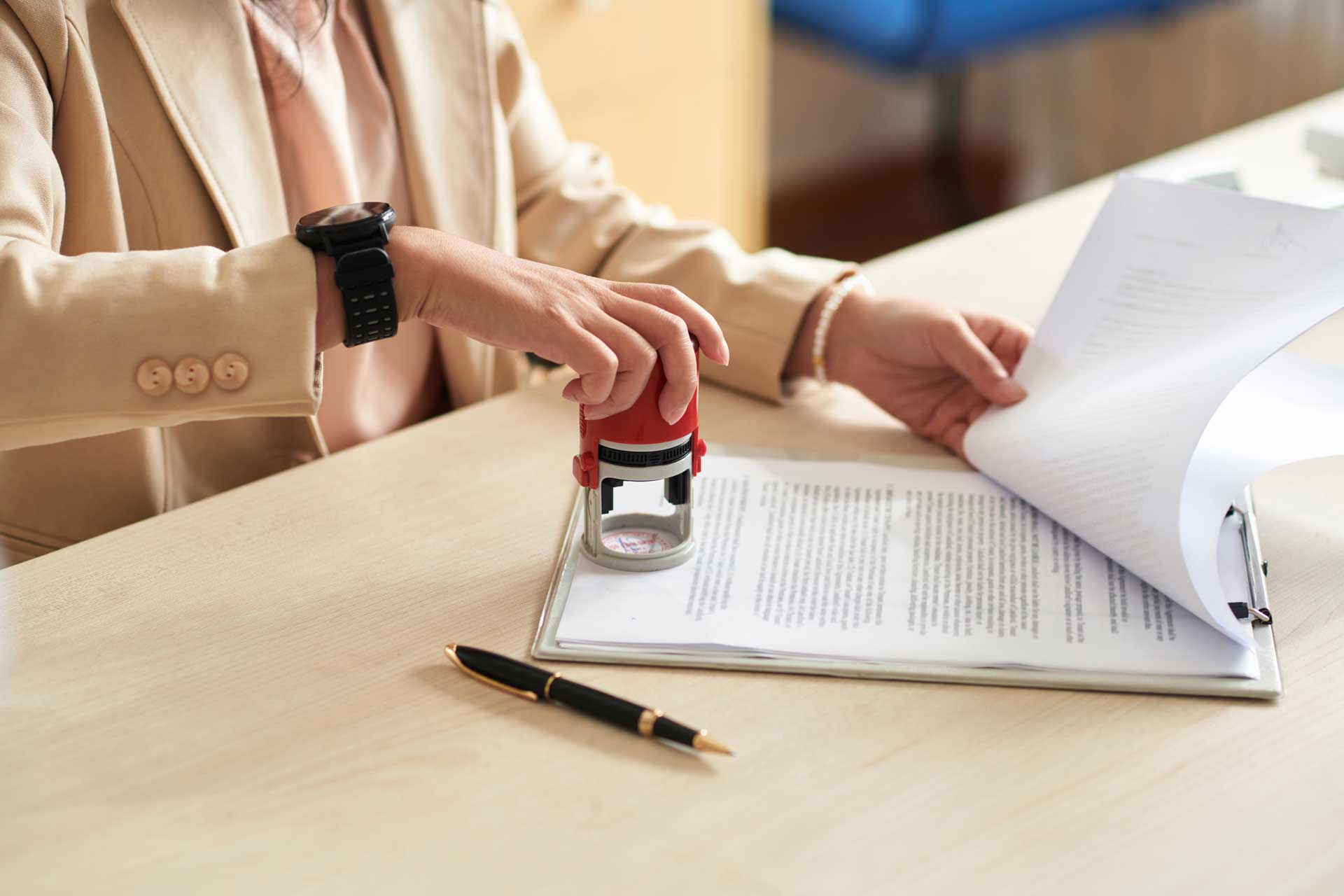How to Handle Remote Online Notarization (RON): A Step-by-Step Guide
Table of Contents
Remote Online Notarization (RON) has become increasingly popular. It provides a convenient and secure way for notaries to authenticate documents without being physically present with the signer. RON allows notaries to perform their duties via video conferencing while adhering to strict security protocols. Although RON simplifies the notarization process, it requires careful attention to detail and compliance with state-specific regulations.
This guide will walk you through the steps of handling remote online notarization and common challenges to avoid, as well as provide a few key insights to ensure you maintain proper procedure.
What Is Remote Online Notarization (RON)?
Remote Online Notarization is a process that allows notaries to notarize documents online, using secure digital platforms to communicate with the signer. The notary verifies the signer’s identity, witnesses the signature, and applies their digital seal—all without meeting the signer in person. This process saves time and broadens the scope of notarial services, making them accessible to people in remote locations.
RON differs from traditional notarization in that the process is conducted electronically, often requiring advanced verification methods to confirm the signer’s identity. States like Florida, Texas, and Virginia have fully embraced RON, but the requirements and permitted technologies can vary across states.
Understanding State-Specific RON Requirements
Before you can perform RON, it’s critical to understand your state’s specific rules and regulations. Not all states permit RON, and those that do may have different registration, technology, and training requirements. For example:
- Florida requires notaries to complete additional training and register with the state before performing RON.
- Texas mandates that notaries use state-approved platforms and meet specific security protocols.
- Virginia was one of the first states to adopt RON, which includes strict guidelines for identity verification and video recording.
States Permitting RON:
| State | RON Approved | Additional Training Required |
| Florida | Yes | Yes |
| Texas | Yes | Yes |
| Virginia | Yes | No |
If your state requires RON-specific training or registration, make sure to complete this step before offering online notarization services.
Select an Approved RON Platform
Not all digital platforms are suitable for RON. States that permit RON often list approved platforms that meet their security and compliance standards. These platforms use a combination of video conferencing, identity verification, and secure electronic signatures to ensure that the notarization process is legitimate and legally binding.
Some widely used platforms for RON include:
- Notarize
- DocVerify
- Signix
- Pavaso
These platforms are designed to ensure the entire notarization session is recorded and securely stored, a requirement in most states.
Verify the Signer’s Identity
One critical step in the RON process is verifying the signer’s identity remotely. Traditional notarizations require the signer to present a government-issued ID in person, but RON uses advanced technology to digitally confirm the signer’s identity.
Standard Methods of Identity Verification:
- Knowledge-Based Authentication (KBA): The signer answers personal questions based on their credit history or public records.
- Credential Analysis: The RON platform electronically verifies the validity of the signer’s government-issued ID.
- Facial Recognition: Some platforms use facial recognition software to compare the signer’s appearance with their ID photo.
These verification methods ensure that the signer is who they claim to be, adding an extra layer of security to the RON process.
Read More: Necessary Requirements to Become a Notary
Conduct the Notarization Session
Once the signer’s identity has been verified, the next step is notarization via video conferencing. The notary and the signer must be present on the approved platform, and the entire session must be recorded. During the session:
- The notary will confirm that the signer is signing the document voluntarily.
- The signer will electronically sign the document while the notary witnesses the action.
- The notary will apply their digital seal and signature.
It’s essential to ensure that the session is free from interruptions and that all parties clearly understand the process. If any issues arise, the notary should pause the session and resolve the problem before continuing.
Apply the Digital Seal and Certificate
After signing the document, the notary must apply their digital seal and complete the notarial certificate. This step is similar to the traditional process but requires digital tools. The notary’s digital seal confirms the document’s authenticity and prevents tampering.
The notarial certificate should include the following:
- The date of notarization.
- The notary’s digital signature and seal.
- The remote location of the notary and the signer (if required by the state).
Ensure that your digital seal complies with your state’s requirements. Each state may have different guidelines regarding what information must be included in the digital seal.
Record and Retain the Notarization Session
Most states that permit RON require the entire video session to be recorded and securely stored. This record proves that the notarization was correctly conducted and can be referenced in a legal dispute. Platforms like Notarize and DocVerify typically offer automatic recording and storage solutions to meet these requirements.
The length of time that records must be retained varies by state. For example, Florida requires notaries to maintain records of the RON session for at least ten years, while Texas requires a minimum of 5 years. Check your state’s retention requirements and store the records securely.
Common Mistakes to Avoid in RON
Even though RON is designed to streamline the notarization process, there are still common mistakes that notaries should avoid to ensure compliance:
- Using an Unapproved Platform: Always verify that your state approves your RON platform before conducting a notarization.
- Failing to Record the Session: Ensure the entire notarization session, including video and audio, is recorded and stored according to state regulations.
- Inadequate Identity Verification: Ensure the signer passes Knowledge-Based Authentication and Credential Analysis as required.
- Neglecting to Retain Records: Don’t overlook the importance of retaining the session’s video recording and electronic records.
The Future of Remote Online Notarization
RON has gained significant traction over the past few years, and more states will likely adopt RON legislation. The COVID-19 pandemic accelerated the need for remote services, and many states that did not previously permit RON are now considering its adoption. As technology improves, we can expect more secure and efficient ways to perform RON.
Notaries should stay informed about RON law changes and remain current on their state’s specific requirements. This is especially important as new technology, such as blockchain and enhanced identity verification methods, is integrated into the RON process.
Ready to Handle Remote Online Notarization Effectively?
Remote Online Notarization offers a convenient, secure way to notarize documents. Notaries can ensure they perform RON legally and effectively without needing in-person meetings. They perform RON lawfully and efficiently by selecting an approved platform and properly verifying the signer’s identity. Start streamlining your notarizations today by embracing this modern solution!For more detailed guidance on handling RON in your state, check out the resources available at the Notary Public Association. These materials will help you stay compliant, improve your skills, and successfully navigate the Remote Online Notarization process.
Share:
Disclaimer: All information provided by Notary Public Association is for educational purposes only and is not intended as legal advice. Notary Public Association makes no representations or warranties as to the accuracy, completeness, or applicability of the information provided and assumes no liability for any actions taken in reliance on it. Always consult a licensed attorney or your local commissioning authority for guidance specific to your notary responsibilities and jurisdiction.
Related Posts

Necessary Requirements to Become a Notary
Dive into the journey of becoming a notary: understand eligibility, training, bonding, and application steps. A guide to kickstart your notary career.

California Notary Training: What to Expect
Learn what to expect from CA Notary Training: eligibility, course details, and exam prep for a successful notary career in the Golden State.

